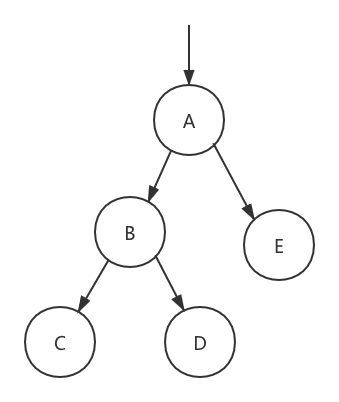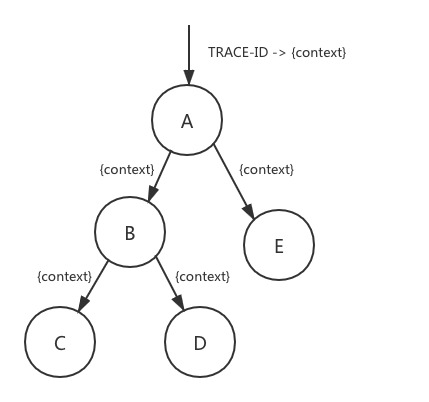Go - 實現專案內鏈路追蹤
阿新 • • 發佈:2021-02-02
為什麼專案內需要鏈路追蹤?當一個請求中,請求了多個服務單元,如果請求出現了錯誤或異常,很難去定位是哪個服務出了問題,這時就需要鏈路追蹤。

從圖中可以清晰的看出他們之間的呼叫關係,通過一個例子說明下鏈路的重要性,比如對方調我們一個介面,反饋在某個時間段這介面太慢了,在排查程式碼發現邏輯比較複雜,不光呼叫了多個三方介面、操作了資料庫,還操作了快取,怎麼快速定位是哪塊執行時間很長?
不賣關子,先說下本篇文章最終實現了什麼,如果感興趣再繼續往下看。
實現了通過記錄如下引數,來進行問題定位,關於每個引數的結構在下面都有介紹。
```
// Trace 記錄的引數
type Trace struct {
mux sync.Mutex
Identifier string `json:"trace_id"` // 鏈路 ID
Request *Request `json:"request"` // 請求資訊
Response *Response `json:"response"` // 響應資訊
ThirdPartyRequests []*Dialog `json:"third_party_requests"` // 呼叫第三方介面的資訊
Debugs []*Debug `json:"debugs"` // 除錯資訊
SQLs []*SQL `json:"sqls"` // 執行的 SQL 資訊
Redis []*Redis `json:"redis"` // 執行的 Redis 資訊
Success bool `json:"success"` // 請求結果 true or false
CostSeconds float64 `json:"cost_seconds"` // 執行時長(單位秒)
}
```
## 引數結構
### 鏈路 ID
`String` 例如:4b4f81f015a4f2a01b00。如果請求 Header 中存在 `TRACE-ID`,就使用它,反之,重新建立一個。將 `TRACE_ID` 放到介面返回值中,這樣就可以通過這個標示查到這一串的資訊。
### 請求資訊
`Object`,結構如下:
```
type Request struct {
TTL string `json:"ttl"` // 請求超時時間
Method string `json:"method"` // 請求方式
DecodedURL string `json:"decoded_url"` // 請求地址
Header interface{} `json:"header"` // 請求 Header 資訊
Body interface{} `json:"body"` // 請求 Body 資訊
}
```
### 響應資訊
`Object`,結構如下:
```
type Response struct {
Header interface{} `json:"header"` // Header 資訊
Body interface{} `json:"body"` // Body 資訊
BusinessCode int `json:"business_code,omitempty"` // 業務碼
BusinessCodeMsg string `json:"business_code_msg,omitempty"` // 提示資訊
HttpCode int `json:"http_code"` // HTTP 狀態碼
HttpCodeMsg string `json:"http_code_msg"` // HTTP 狀態碼資訊
CostSeconds float64 `json:"cost_seconds"` // 執行時間(單位秒)
}
```
### 呼叫三方介面資訊
`Object`,結構如下:
```
type Dialog struct {
mux sync.Mutex
Request *Request `json:"request"` // 請求資訊
Responses []*Response `json:"responses"` // 返回資訊
Success bool `json:"success"` // 是否成功,true 或 false
CostSeconds float64 `json:"cost_seconds"` // 執行時長(單位秒)
}
```
這裡面的 `Request` 和 `Response` 結構與上面保持一致。
細節來了,為什麼 `Responses` 結構是 `[]*Response` ?
是因為 HTTP 可以進行重試請求,比如當請求對方介面的時候,HTTP 狀態碼為 503 `http.StatusServiceUnavailable`,這時需要重試,我們也需要把重試的響應資訊記錄下來。
### 除錯資訊
`Object` 結構如下:
```
type Debug struct {
Key string `json:"key"` // 標示
Value interface{} `json:"value"` // 值
CostSeconds float64 `json:"cost_seconds"` // 執行時間(單位秒)
}
```
### SQL 資訊
`Object`,結構如下:
```
type SQL struct {
Timestamp string `json:"timestamp"` // 時間,格式:2006-01-02 15:04:05
Stack string `json:"stack"` // 檔案地址和行號
SQL string `json:"sql"` // SQL 語句
Rows int64 `json:"rows_affected"` // 影響行數
CostSeconds float64 `json:"cost_seconds"` // 執行時長(單位秒)
}
```
### Redis 資訊
`Object`,結構如下:
```
type Redis struct {
Timestamp string `json:"timestamp"` // 時間,格式:2006-01-02 15:04:05
Handle string `json:"handle"` // 操作,SET/GET 等
Key string `json:"key"` // Key
Value string `json:"value,omitempty"` // Value
TTL float64 `json:"ttl,omitempty"` // 超時時長(單位分)
CostSeconds float64 `json:"cost_seconds"` // 執行時間(單位秒)
}
```
### 請求結果
`Bool`,這個和統一定義返回值有點關係,看下程式碼:
```
// 錯誤返回
c.AbortWithError(code.ErrParamBind.WithErr(err))
// 正確返回
c.Payload(code.OK.WithData(data))
```
當錯誤返回時 且 `ctx.Writer.Status() != http.StatusOK` 時,為 `false`,反之為 `true`。
### 執行時長
`Float64`,例如:0.041746869,記錄的是從請求開始到請求結束所花費的時間。
## 如何收集引數?
這時有老鐵會說了:“規劃的稍微還行,使用的時候會不會很麻煩?”
“No,No,使用起來一丟丟都不麻煩”,接著往下看。
### 無需關心的引數
鏈路 ID、請求資訊、響應資訊、請求結果、執行時長,這 5 個引數,開發者無需關心,這些都在中介軟體封裝好了。
### 呼叫第三方介面的資訊
只需多傳遞一個引數即可。
在這裡厚臉皮自薦下 [httpclient 包](https://mp.weixin.qq.com/s/IxvzNPI18OEYmCL5uH4jCA) 。
- 支援設定失敗時重試,可以自定義重試次數、重試前延遲等待時間、重試的滿足條件;
- 支援設定失敗時告警,可以自定義告警渠道(郵件/微信)、告警的滿足條件;
- 支援設定呼叫鏈路;
呼叫示例程式碼:
```
// httpclient 是專案中封裝的包
api := "http://127.0.0.1:9999/demo/post"
params := url.Values{}
params.Set("name", name)
body, err := httpclient.PostForm(api, params,
httpclient.WithTrace(ctx.Trace()), // 傳遞上下文
)
```
### 除錯資訊
只需多傳遞一個引數即可。
呼叫示例程式碼:
```
// p 是專案中封裝的包
p.Println("key", "value",
p.WithTrace(ctx.Trace()), // 傳遞上下文
)
```
### SQL 資訊
稍微複雜一丟丟,需要多傳遞一個引數,然後再寫一個 `GORM` 外掛。
使用的 `GORM V2` 自帶的 `Callbacks` 和 `Context` 知識點,細節不多說,可以看下這篇文章:[基於 GORM 獲取當前請求所執行的 SQL 資訊](https://mp.weixin.qq.com/s/zDXEkO9AQK5INf0JcNQITg)。
呼叫示例程式碼:
```
// 原來查詢這樣寫
err := u.db.GetDbR().
First(data, id).
Where("is_deleted = ?", -1).
Error
// 現在只需這樣寫
err := u.db.GetDbR().
WithContext(ctx.RequestContext()).
First(data, id).
Where("is_deleted = ?", -1).
Error
// .WithContext 是 GORM V2 自帶的。
// 外掛的程式碼就不貼了,去上面的文章檢視即可。
```
### Redis 資訊
只需多傳遞一個引數即可。
呼叫示例程式碼:
```
// cache 是基於 go-redis 封裝的包
d.cache.Get("name",
cache.WithTrace(c.Trace()),
)
```
## 核心原理是啥?
在這沒關子可賣,看到這相信老鐵們都知道了,就兩個:一個是 攔截器,另一個是 `Context`。

## 如何記錄引數?
將以上資料轉為 `JSON` 結構記錄到日誌中。
### JSON 示例
```
{
"level":"info",
"time":"2021-01-30 22:32:48",
"caller":"core/core.go:444",
"msg":"core-interceptor",
"domain":"go-gin-api[fat]",
"method":"GET",
"path":"/demo/trace",
"http_code":200,
"business_code":1,
"success":true,
"cost_seconds":0.054025302,
"trace_id":"2cdb2f96934f573af391",
"trace_info":{
"trace_id":"2cdb2f96934f573af391",
"request":{
"ttl":"un-limit",
"method":"GET",
"decoded_url":"/demo/trace",
"header":{
"Accept":[
"application/json"
],
"Accept-Encoding":[
"gzip, deflate, br"
],
"Accept-Language":[
"zh-CN,zh;q=0.9,en;q=0.8"
],
"Authorization":[
"eyJhbGciOiJIUzI1NiIsInR5cCI6IkpXVCJ9.eyJVc2VySUQiOjEsIlVzZXJOYW1lIjoieGlubGlhbmdub3RlIiwiZXhwIjoxNjEyMTAzNTQwLCJpYXQiOjE2MTIwMTcxNDAsIm5iZiI6MTYxMjAxNzE0MH0.2yHDdP7cNT5uL5xA0-j_NgTK4GrW-HGn0KUxcbZfpKg"
],
"Connection":[
"keep-alive"
],
"Referer":[
"http://127.0.0.1:9999/swagger/index.html"
],
"Sec-Fetch-Dest":[
"empty"
],
"Sec-Fetch-Mode":[
"cors"
],
"Sec-Fetch-Site":[
"same-origin"
],
"User-Agent":[
"Mozilla/5.0 (Macintosh; Intel Mac OS X 10_15_6) AppleWebKit/537.36 (KHTML, like Gecko) Chrome/88.0.4324.96 Safari/537.36"
]
},
"body":""
},
"response":{
"header":{
"Content-Type":[
"application/json; charset=utf-8"
],
"Trace-Id":[
"2cdb2f96934f573af391"
],
"Vary":[
"Origin"
]
},
"body":{
"code":1,
"msg":"OK",
"data":[
{
"name":"Tom",
"job":"Student"
},
{
"name":"Jack",
"job":"Teacher"
}
],
"id":"2cdb2f96934f573af391"
},
"business_code":1,
"business_code_msg":"OK",
"http_code":200,
"http_code_msg":"OK",
"cost_seconds":0.054024874
},
"third_party_requests":[
{
"request":{
"ttl":"5s",
"method":"GET",
"decoded_url":"http://127.0.0.1:9999/demo/get/Tom",
"header":{
"Authorization":[
"eyJhbGciOiJIUzI1NiIsInR5cCI6IkpXVCJ9.eyJVc2VySUQiOjEsIlVzZXJOYW1lIjoieGlubGlhbmdub3RlIiwiZXhwIjoxNjEyMTAzNTQwLCJpYXQiOjE2MTIwMTcxNDAsIm5iZiI6MTYxMjAxNzE0MH0.2yHDdP7cNT5uL5xA0-j_NgTK4GrW-HGn0KUxcbZfpKg"
],
"Content-Type":[
"application/x-www-form-urlencoded; charset=utf-8"
],
"TRACE-ID":[
"2cdb2f96934f573af391"
]
},
"body":null
},
"responses":[
{
"header":{
"Content-Length":[
"87"
],
"Content-Type":[
"application/json; charset=utf-8"
],
"Date":[
"Sat, 30 Jan 2021 14:32:48 GMT"
],
"Trace-Id":[
"2cdb2f96934f573af391"
],
"Vary":[
"Origin"
]
},
"body":"{"code":1,"msg":"OK","data":{"name":"Tom","job":"Student"},"id":"2cdb2f96934f573af391"}",
"http_code":200,
"http_code_msg":"200 OK",
"cost_seconds":0.000555089
}
],
"success":true,
"cost_seconds":0.000580202
},
{
"request":{
"ttl":"5s",
"method":"POST",
"decoded_url":"http://127.0.0.1:9999/demo/post",
"header":{
"Authorization":[
"eyJhbGciOiJIUzI1NiIsInR5cCI6IkpXVCJ9.eyJVc2VySUQiOjEsIlVzZXJOYW1lIjoieGlubGlhbmdub3RlIiwiZXhwIjoxNjEyMTAzNTQwLCJpYXQiOjE2MTIwMTcxNDAsIm5iZiI6MTYxMjAxNzE0MH0.2yHDdP7cNT5uL5xA0-j_NgTK4GrW-HGn0KUxcbZfpKg"
],
"Content-Type":[
"application/x-www-form-urlencoded; charset=utf-8"
],
"TRACE-ID":[
"2cdb2f96934f573af391"
]
},
"body":"name=Jack"
},
"responses":[
{
"header":{
"Content-Length":[
"88"
],
"Content-Type":[
"application/json; charset=utf-8"
],
"Date":[
"Sat, 30 Jan 2021 14:32:48 GMT"
],
"Trace-Id":[
"2cdb2f96934f573af391"
],
"Vary":[
"Origin"
]
},
"body":"{"code":1,"msg":"OK","data":{"name":"Jack","job":"Teacher"},"id":"2cdb2f96934f573af391"}",
"http_code":200,
"http_code_msg":"200 OK",
"cost_seconds":0.000450153
}
],
"success":true,
"cost_seconds":0.000468387
}
],
"debugs":[
{
"key":"res1.Data.Name",
"value":"Tom",
"cost_seconds":0.000005193
},
{
"key":"res2.Data.Name",
"value":"Jack",
"cost_seconds":0.000003907
},
{
"key":"redis-name",
"value":"tom",
"cost_seconds":0.000009816
}
],
"sqls":[
{
"timestamp":"2021-01-30 22:32:48",
"stack":"/Users/xinliang/github/go-gin-api/internal/api/repository/db_repo/user_demo_repo/user_demo.go:76",
"sql":"SELECT `id`,`user_name`,`nick_name`,`mobile` FROM `user_demo` WHERE user_name = 'test_user' and is_deleted = -1 ORDER BY `user_demo`.`id` LIMIT 1",
"rows_affected":1,
"cost_seconds":0.031969072
}
],
"redis":[
{
"timestamp":"2021-01-30 22:32:48",
"handle":"set",
"key":"name",
"value":"tom",
"ttl":10,
"cost_seconds":0.009982091
},
{
"timestamp":"2021-01-30 22:32:48",
"handle":"get",
"key":"name",
"cost_seconds":0.010681579
}
],
"success":true,
"cost_seconds":0.054025302
}
}
```
### zap 日誌元件
有對日誌收集感興趣的老鐵們可以往下看,`trace_info` 只是日誌的一個引數,具體日誌引數包括:
| 引數 | 資料型別 | 說明 |
| ------------- | -------- | -------------------------------------------- |
| level | String | 日誌級別,例如:info,warn,error,debug |
| time | String | 時間,例如:2021-01-30 16:05:44 |
| caller | String | 呼叫位置,檔案+行號,例如:core/core.go:443 |
| msg | String | 日誌資訊,例如:xx 錯誤 |
| domain | String | 域名或服務名,例如:go-gin-api[fat] |
| method | String | 請求方式,例如:POST |
| path | String | 請求路徑,例如:/user/create |
| http_code | Int | HTTP 狀態碼,例如:200 |
| business_code | Int | 業務狀態碼,例如:10101 |
| success | Bool | 狀態,true or false |
| cost_seconds | Float64 | 花費時間,單位:秒,例如:0.01 |
| trace_id | String | 鏈路ID,例如:ec3c868c8dcccfe515ab |
| trace_info | Object | 鏈路資訊,結構化資料。 |
| error | String | 錯誤資訊,當出現錯誤時才有這欄位。 |
| errorVerbose | String | 詳細的錯誤堆疊資訊,當出現錯誤時才有這欄位。 |
日誌記錄可以使用 `zap`,`logrus` ,這次我使用的 `zap`,簡單封裝一下即可,比如:
- 支援設定日誌級別;
- 支援設定日誌輸出到控制檯;
- 支援設定日誌輸出到檔案;
- 支援設定日誌輸出到檔案(可自動分割);
## 總結
這個功能比較常用,使用起來也很爽,比如呼叫方發現接口出問題時,只需要提供 `TRACE-ID` 即可,我們就可以查到關於它整個鏈路的所有資訊。
> 以上程式碼的實現都在 go-gin-api 專案中,地址:https://github.com/xinliangnote/go-
